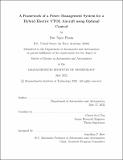A Framework of a Power Management System for a Hybrid Electric VTOL Aircraft using Optimal Control
Author(s)
Pham, Duc Ngoc
DownloadThesis PDF (11.65Mb)
Advisor
Tan, Choon Sooi
Terms of use
Metadata
Show full item recordAbstract
The operation of a hybrid fixed-wing vertical takeoff and landing unmanned aerial vehicle (VTOL UAV) is assessed using an optimal control framework for the most energy-efficient and time-efficient trajectories. The UAV is equipped with a modular hybrid propulsion system (MHPS) where the electrical and carbon-fuel system components are interchangeable on a mission-to-mission basis, enabling aircraft performance flexibility. The framework is used to assess the effects of MHPS electric power hybridization, energy hybridization mass ratio, and peak power output on UAV performance during demanding phases of flight, which include takeoff, landing, and hover. Results showed that the most time and energy efficient takeoff trajectories involved minimizing the vertical displacement gained during the transition from vertical to horizontal flight. The power management strategy for minimum energy consumption during takeoff, landing, and hover was largely dictated by propulsion component efficiencies; maximizing the electric motor power and minimizing the carbon fuel power would reduce energy consumption. As peak power output and electric power hybridization increased, takeoff and landing energy consumption decreased. Minimum time takeoff and landing trajectories and power management strategy were only dependent on power-to-weight ratio; a higher peak power output reduced takeoff and landing time. The power management strategy for efficient hover mirrored that of takeoff and landing; a higher peak power output resulted in less energy consumed. A preliminary assessment of the tradeoffs of electrification was conducted using a takeoff/cruise endurance non-dimensional performance group given as the ratio of the product of peak power output and cruise endurance to the total energy consumed during takeoff. Increasing electric power hybridization adversely affected overall aircraft performance, due to the reduction in cruise range and endurance. For each selected value of electric power hybridization, there is an optimal peak power output that strikes the best balance between takeoff and cruise performance. For short, demanding mission segments, like takeoff or landing, the energy hybridization mass ratio has a smaller impact than electric power hybridization, since range or mass changes are not of concern when analyzing independent takeoff or landing performance.
Date issued
2022-05Department
Massachusetts Institute of Technology. Department of Aeronautics and AstronauticsPublisher
Massachusetts Institute of Technology